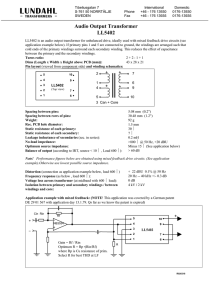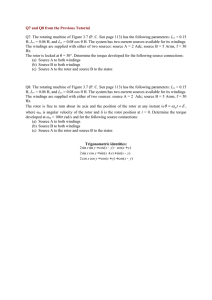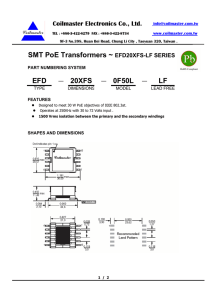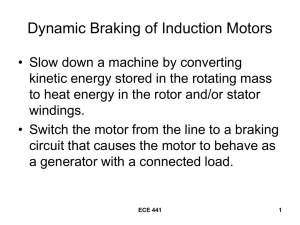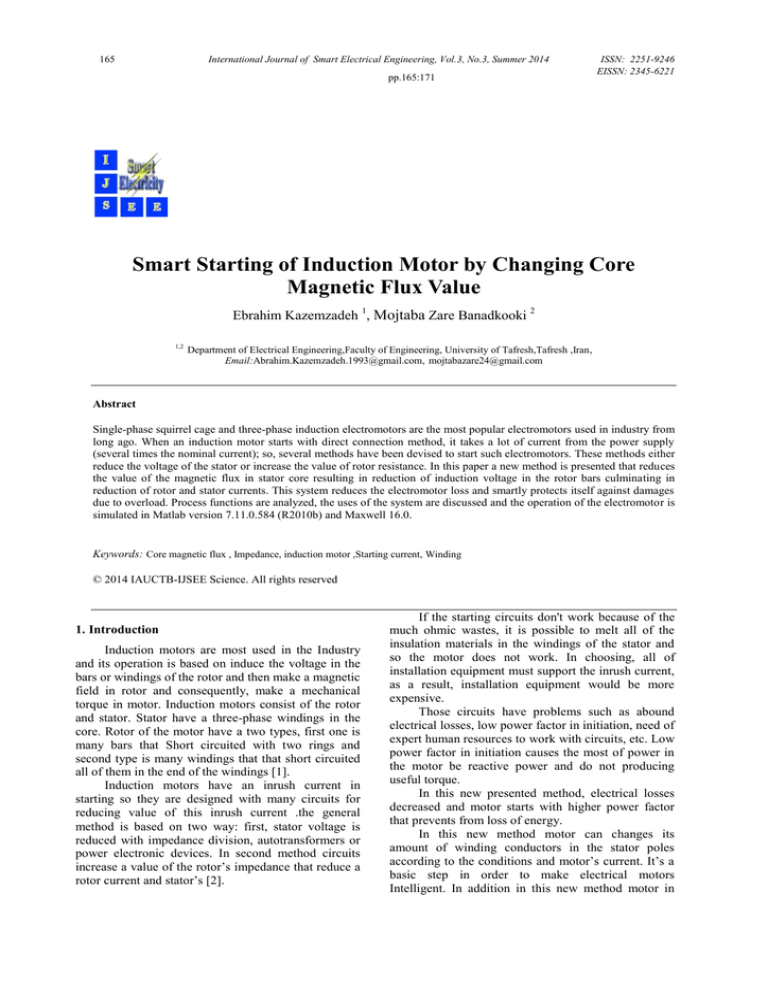
165
International Journal of Smart Electrical Engineering, Vol.3, No.3, Summer 2014
pp.165:171
ISSN: 2251-9246
EISSN: 2345-6221
Smart Starting of Induction Motor by Changing Core
Magnetic Flux Value
Ebrahim Kazemzadeh 1, Mojtaba Zare Banadkooki 2
1,2
Department of Electrical Engineering,Faculty of Engineering, University of Tafresh,Tafresh ,Iran,
Email:Abrahim.Kazemzadeh.1993@gmail.com, mojtabazare24@gmail.com
Abstract
Single-phase squirrel cage and three-phase induction electromotors are the most popular electromotors used in industry from
long ago. When an induction motor starts with direct connection method, it takes a lot of current from the power supply
(several times the nominal current); so, several methods have been devised to start such electromotors. These methods either
reduce the voltage of the stator or increase the value of rotor resistance. In this paper a new method is presented that reduces
the value of the magnetic flux in stator core resulting in reduction of induction voltage in the rotor bars culminating in
reduction of rotor and stator currents. This system reduces the electromotor loss and smartly protects itself against damages
due to overload. Process functions are analyzed, the uses of the system are discussed and the operation of the electromotor is
simulated in Matlab version 7.11.0.584 (R2010b) and Maxwell 16.0.
Keywords: Core magnetic flux , Impedance, induction motor ,Starting current, Winding
© 2014 IAUCTB-IJSEE Science. All rights reserved
1. Introduction
Induction motors are most used in the Industry
and its operation is based on induce the voltage in the
bars or windings of the rotor and then make a magnetic
field in rotor and consequently, make a mechanical
torque in motor. Induction motors consist of the rotor
and stator. Stator have a three-phase windings in the
core. Rotor of the motor have a two types, first one is
many bars that Short circuited with two rings and
second type is many windings that that short circuited
all of them in the end of the windings [1].
Induction motors have an inrush current in
starting so they are designed with many circuits for
reducing value of this inrush current .the general
method is based on two way: first, stator voltage is
reduced with impedance division, autotransformers or
power electronic devices. In second method circuits
increase a value of the rotor’s impedance that reduce a
rotor current and stator’s [2].
If the starting circuits don't work because of the
much ohmic wastes, it is possible to melt all of the
insulation materials in the windings of the stator and
so the motor does not work. In choosing, all of
installation equipment must support the inrush current,
as a result, installation equipment would be more
expensive.
Those circuits have problems such as abound
electrical losses, low power factor in initiation, need of
expert human resources to work with circuits, etc. Low
power factor in initiation causes the most of power in
the motor be reactive power and do not producing
useful torque.
In this new presented method, electrical losses
decreased and motor starts with higher power factor
that prevents from loss of energy.
In this new method motor can changes its
amount of winding conductors in the stator poles
according to the conditions and motor’s current. It’s a
basic step in order to make electrical motors
Intelligent. In addition in this new method motor in
166
International Journal of Smart Electrical Engineering, Vol.3, No.3, Summer 2014
Overloads is able to protect insulation materials of
windings from burning.
This method is very simple and cheaper than
previous methods and has ability to implement this
method on motor manufacturers and also starting
circuits would be removed from all industrial centers
and anyone can use the induction motors and there is
no need for special experts and briefly this method
reduces the cost of working with motors.
In other words in this new method there are
designed circuits for starting motors and a new way for
protecting them.
In addition to the benefits that noted ,this
proposed scheme has disadvantages such as more
voluminous stator , increase in the cost of finished
motor, the need for insulation of moving parts,
requiring cooling systems for microcontroller section,
etc.
2. Description of system operation
In this new method that is presented for the first
time, magnetic flux directly reduced. In the stator Core
in each phase in addition to main windings of stator
poles we added number of winding that these new
windings are in the same direction of main windings of
the stator poles (for example both in clockwise
direction).These added windings in the starting a
motor are serried with the windings of stator poles so
magnetic flux reduced in the stator core (checked in
next section). Now Induced voltage will reduced in the
rotor (secondary part of the rotary transformer) so
rotor current get reduced. Since the induction motor is
like a rotary transformer, stator current reduced. In
other words when the resultant number of turns
Increases, seen Impedance from stator increases and
then causes reduction in inrush current.
After starting the motor and in normal operation,
added windings are removed from windings of the
stator poles and just main windings of the stator poles
are in the circuit so it reduces Resultant number of
turns and Increases value of the magnetic flux in the
core and then motor works in normal mode (just main
windings of the stator poles are in clockwise direction
in the circuit). In other words in the starting mode all
of the added windings are serried in the circuit and
when the motor starts all of this added windings will
gradually removed from circuit.
All of this acts happen by an intelligent system
namely proportional with the current of the windings
of the stator poles and a program that has been written
in the microcontroller, motor automatically series
added windings in circuit or removed it from circuit.
Strategy of the adding or removing added
windings is similar to strategy of the adding or
removing windings in the autotransformers. The
general form of the system presented in Figure 1.
ISSN: 2251-9246
EISSN: 2345-6221
Fig. 1. The general structure of the system for each phase.
3. Formulas and Equations
As previously mentioned, in this new method we
reduced value of the magnetic flux in the core and by
this method we decrease initiation current. This work
does with the following equations.
The equivalent circuit of Induction motors is
according to figure 2 [3].
Fig. 2. Transformer model for induction motors for one phase
In section 2 we mentioned that stator has two
type winding, the first type is windings of the stator
poles and second is added windings are both in same
direction that in the starting all of the added windings
are in the circuit and when the motor start, all of this
added windings gradually removed from circuit. Now
the number of windings turns in the circuit obtained
from equation 1[4].
Neq=Ncs+Nccs
(1)
That in this equation Neq represents the number
of resultant stator windings in the circuit, Ncs
represents the number of windings of the stator poles,
Nccs represents the number of added windings that are
in the circuit. Now the magnetic flux in the core
obtained from equation 2[5].
(2)
φ=
∗
This equation represents the current in the stator
windings; R represents reluctance of flux path. Value
of R depend on motor physical size and is constant but
value of the Neq and I change in this system.
If the voltage has a zero degree then value of the
current will be obtained from equation 3[6].
167
International Journal of Smart Electrical Engineering, Vol.3, No.3, Summer 2014
(3)
∗
Seen Impedance from stator obtained from
equation 4[7].
(4)
∗
In this equation Z represents the seen impedance
from stator, Zr represents the impedance of the rotor,
Nr represents number of turns of winding rotor.
Usually Z is given in specifications of motors so seen
Impedance from stator after Neq is changed based on
Z, is obtained according to Equation 5.
∗
According to equation 2, 3 and 10 magnetic flux in
the core obtained from equation 11 and 12.
∗
∗
(6)
(7)
∗
In this equation Xm represents the magnetizing
inductance, Rm reluctance of core, NS represents the
number of stator windings turns and ω is a 2*π*f that f
is a source frequency.
According to Equation 7, new magnetizing
inductance when Neq is changed is:
(8)
In this equation Xm new represents magnetizing
inductance with Neq new value of resultant stator
windings in the circuit and Xm old represents
magnetizing inductance with Neq old value of
resultant stator windings in the circuit.
Because added some turns to windings of stator,
stator Impedance Proportional to Ratio increased is
increased. Value of increased Impedance in the stator
obtained from Equation 8.
∗
(9)
In Figure 2, seen Impedance from Source is The
resulting series of stator Impedance Sum with The
resulting parallel of a Magnetizing inductance and
rotor Impedance. According to Equation 5,7,8 in the
seen Impedance from Source There are a Factor of
((Neq new)/(Neq old)). seen Impedance from Source
obtained from Equation 9.
(11)
∗
∗
∗
In this equation Zold represents seen Impedance
from stator with Neq old value of resultant stator
windings in the circuit and Znew represents the seen
Impedance from stator with Neq new value of resultant
stator windings in the circuit. Another way to write the
equation of 6 is this. Magnetizing inductance obtained
from equation 7[8].
∗
∗
(5)
∗
(10)
∗
In this equation Rs represents stator resistance, Xs
represents stator reactance, Rr represents rotor
resistance, Xr represents rotor reactance and Zin
represents seen impedance from source.
∗
∗
ISSN: 2251-9246
EISSN: 2345-6221
(12)
By comparing the equation 11 and 12 realize that
with increasing number of turns in windings of the
stator poles (Increasing Neq), magnetic flux in the core
decreases.
Induction voltage in the rotor windings obtained
from equation 13[9].
∗
∗
∗
∗
(13)
In this equation Kwr represents winding factor of
the rotor (0<Kwr<1), Nwr represents the number of
turns in windings of the rotor, fr represents rotor
voltage frequency and
represents maximum
magnetic flux in the core.
Now Induction voltage in the rotor make an
electrical current and obtained from equation 14[10].
∗
(14)
In this equation S represents slip from sync speed
and obtained from equation 14[11].
(15)
In this equation Ws represents the sync speed
and Wr represents motor speed.
Briefly in the starting mode according to equation
11 with adding a some turns in the circuit, Neq
increases then value of the magnetic flux in the core
and maximum magnetic flux in the core are decreased
and according to equation 13 induction voltage in the
rotor decreased and then according to equation 14
electrical current decreases in the rotor and because of
the induction motors are like rotary transformer so
electrical current in the stator decreases.
Nominal current in the windings of the stator poles
obtained from equation 16[12]. That in initiation with
direct method it will use from 6 to 11 times more
current.
168
International Journal of Smart Electrical Engineering, Vol.3, No.3, Summer 2014
∗
(15)
∗
4. System protection
In previous starting methods a protective system is
needed in addition to the starting one. In other words, a
series of circuits are installed in the control panel for
starting and other ones for protecting the insulators of
induction electromotor. In the new suggested system a
current sensor (Fig. 1) measures the current
continuously and when the current exceeds the nominal
limit, a series of extra windings (winded in the same
direction as the main ones) are entered into the system
and decrease the current. In other words, Neq windings
are increased and the flux of the electromotor is
decreased according to equation 9 and then the
induction voltage in rotor is decreased according to
equation 11 and the rotor current is decreased
accordingly according to equation 12 and since the
induction electromotor is like a rotating transformer,
starter current is decreased proportionally and the
insulators of the windings of the starter are protected
against high current.
5. An example of the operation of electromotor
used, the starting current will be several times less than
the direct connection method and the windings of the
electromotor will not be damaged.
After starting, the current will be less than the
nominal value and the extra 48 windings will exit the
system gradually and Neq decreases gradually and the
current is increased until the extra windings exit
completely and Neq=66 and the current reaches the
nominal current of 126.61 amperes.
6. Comparison
Starting with former methods decreases the power
factor of the electromotor due to addition of impedance
in starter or rotor (0.3-0.2 after phase), but in this
method, the power factor remains fixed approximately.
According to Fig. 2, when the new windings are
added in the same direction of starter’s windings, the
impedance of the starter increases. In other words, both
the resistance and reactance of the starter increase. On
the other hand, with the decrease of windings, aeff will
decrease.
Therefore, in the electromotor suggested in 2.4, the
impedance in 70 windings and in starting conditions
will be:
∗
In order to show the operation of the system, we
assume an electromotor with the following
specifications and analyze the operation of the system.
Assume a three-phase 75 kw bipolar induction
electromotor with Y connection and 0.9 power factor
and 380 volts with the following specifications:
starter’s resistance: 0.17 ohms, starter’s reactance:
0.125 ohms, resistance transferred to rotor’s starter:
0.17 ohms, reactance transferred to the rotor’s starter:
0.125, core reactance: 10 ohms.
Nominal current of the above electromotor, by
virtue of equation 6, is 126.61 amperes, but at the time
of starting several times higher current is consumed
that damage windings of starter and rotor’s bars.
ISSN: 2251-9246
EISSN: 2345-6221
(18)
Then, according to equation 3, In other words,
power factor will be 0.8(cos(-36.8)=0. 8).
(19)
Now, for calculating power factor in starting mode
when extra 48 windings are inserted, we have to
calculate impedance values as follows:
According to equation 8, starter’s impedance with
extra 48 windings will be:
∗
∗
∗
(20)
(16)
Windings of the main pole of the starter is 66 and
we have added 48 extra windings in the same direction
as the main ones. The extra 48 windings are serially
attached to the main windings at the time of starting,
thus:
According to equation 6, impedance of starter in
Neq=114 will be:
According to equation 6, Xm new in Neq=114 will
be:
(17)
Neq has increased in comparison with the time
when the 48 windings are absent (Neq=66). Thus, in
equation 9 the maximum flux is decreased and
according to equation 12 the voltage inducted in rotor
is decreased and according to equation 13 the starting
current (s=1) is decreased and since the induction
electromotor is like a rotating transformer, starter’s
current is decreased. In other words, if this system is
(21)
∗
∗
(21)
Thus, impedance in the new system will be:
∗
Based on equation 3 then:
(22)
169
International Journal of Smart Electrical Engineering, Vol.3, No.3, Summer 2014
(23)
In other words, power factor in this mode will be
0.799 .Thus, according to the above equations, power
factor in the new system is higher than the direct
connection method and starting current is decreased
noticeably (from 525.05amperes in direct connection
method to 223.14 amperes in the new system) that is
acceptable with regard to the nominal current.
ISSN: 2251-9246
EISSN: 2345-6221
users who want to use the motor do not requires special
technical knowledge and reduce the costs of expert
labor work.
According to the above proportional, the method of
manufacturing and economic conditions using this
scheme can reduce the costs of using induction motors
in long time and technically make it comfortable
working with this type of motors despite of more
difficult engine manufacturing.
7. Accuracy of results with practical experiment
9. Results and discussion
In experiments because all of coils are not quite on
each other, the whole flux do not pass from all the
number of rounds of coils poles. in other words some
of flux close their pass from fewer number of windings
in coil (for example flux start its pass from first turn
and close it in middle of the coil so flux only passes
from certain number of turns).so less magnetic flux
produce compared with ideal condition and it can be
said that effective number of turns are reduced [13].
The system has been simulated in Maxwell 16.0
and Matlab version 7.11.0.584 (R2010b). The
Induction electromotor has been simulated using
Matlab version 7.11.0.584 (R2010b) and the results
have been as follows (values have been calculated in
part 6).
In other words due to reduction in effective number
of turns toward number of turns calculated in formula,
the motor flux In a practical condition is slightly
increased compared with amount of simulated
flux(with formula 10) so starting current is slightly
increased compared with simulated amount.
Comparing Fig. 3 and Fig. 4, it is evident that
starting current has decreased noticeably when the
suggested system is used. Also, the figures show that
this is a suitable system for starting induction
electromotor as the starting current in this system is
about 76% higher than the nominal current and the
duration of current passage is short; thus, the windings
are not damaged.
This error can be eliminated by slightly increasing
in number of turns, in the other words according to
motor manufacturing technology and how winding
stator it’s possible to increase the number of turns so as
to reach the effective amount in section 5.
8. Technical and economic analysis
The proposed scheme must be analysis in two
perspectives: Operational & economical.
Fig. 3. Starting with direct method without the suggested system
1) In terms of finished cost:
The finished cost of proposed scheme is more than
simple schemes and common schemes. the reason for
this rise in prices is Issues such as Increase in number
of windings, the need for a microcontroller and moving
system, requiring current sensor and more needed
insulation and more volume of stator toward previous
schemes, etc.
2) In terms of performance and working lifetime
and protective equipment:
Because of existence of smart system inside the
stator, the motor starts automatically and without
needing to starting circuit. In addition to starting, the
scheme protects motor from over loads and does this
work without disabling motor (in certain ranges of over
load) toward previous schemes that disabled motor. In
other words with this scheme there is no need to pay
for starting system and motor protection that as a result
reduce the costs. However, this scheme due to protect
the motor in instantaneously against any over current,
increases the useful life of the device. Manpower or
Fig. 4. Starting with direct method with the suggested system
Changes in core flux have been simulated with
Maxwell 16.0 with the results of Fig. 3 and Fig. 4.
Comparing figures 5 and 6 it can be concluded that
maximum core flux has decreased (from 3.55 Teslas to
3.2 Teslas) and this is the cause of decrease of starting
current from the value of Fig. 3 to the value of Fig. 4
(from 525.06 amperes to 223.14 amperes).
170
International Journal of Smart Electrical Engineering, Vol.2, No.4, Fall 2013
ISSN: 2251-9246
EISSN: 2345-6221
10. Conclusion
This plan is a revolutionary step forward in smart
electrometers. In other words, the electromotor adjusts
it's windings in proportion with the current passing the
windings to prevent damage to them. This system
works at the time of starting and in normal function as
well to protect the system.
This system, as mentioned in 5, protects the system
by decreasing flux. This is a new system as in previous
plans the current is decreased using impedance
division or through decrease of voltage of starter’s
windings with the use of an autotransformers or
through increasing rotor’s resistance.
Fig. 6. Starting flux in direct method using the suggested system at
phase A peak
As shown in 6 changes of windings can change
flux effectively and can control the current.
This system can be used in all induction
electromotors (which are highly used in industry). This
plan decreases the costs of using induction
electromotors in industry.
Other systems entail
problems such as high loss at the time of starting
(because they insert impedance both in rotor or starter
at the time of starting), low starting power factor to
normal function power factor, skilled operators, etc. as
well as costs for protecting system by means of
bimetals, etc. All these problems are solved in this
system and there will be no need for several protection
systems all facilitating use of such electrometers. The
user only turns on the electromotor and there will be
no control circuit or protection system and former
necessary requirements such as change of impedance
or voltage are removed and no costly and sensitive
device such as control panel, autotransformer, etc. are
required anymore.
All in all, using this method, induction
electromotors can be operated easily and all the
shortcomings of previous methods are removed and
costs of starting and maintaining induction
electrometers are decreased.
Fig. 5. Starting flux in direct method without the suggested
system at phase A peak
Fig. 7. Flux in normal function without extra windings at phase A
peak
References
[1]
Stephen J. Chapman ,”Electrical Machinery fundamentals”,
New York, Elizabeth A. Jones, McGraw-Hill Higher
Education, pp. 380-384, 2005.
[2]
Stephen J. Chapman ,”Electrical Machinery fundamentals”,
New York, Elizabeth A. Jones, McGraw-Hill Higher
Education, pp. 430-434, 2005.
[3]
Stephen J. Chapman ,”Electrical Machinery fundamentals”,
New York, Elizabeth A. Jones, McGraw-Hill Higher
Education, pp. 389, 2005.
[4]
Stephen J. Chapman ,”Electrical Machinery fundamentals”,
New York, Elizabeth A. Jones, McGraw-Hill Higher
Education, pp. 8-11, 2005.
[5]
Stephen J. Chapman ,”Electrical Machinery fundamentals”,
New York, Elizabeth A. Jones, McGraw-Hill Higher
Education, pp. 11-15, 2005.
[6]
Stephen J. Chapman ,”Electrical Machinery fundamentals”,
New York, Elizabeth A. Jones, McGraw-Hill Higher
Education, pp. 51, 2005.
[7]
Stephen J. Chapman ,”Electrical Machinery fundamentals”,
New York, SIXTH EDITION ,McGraw-Hill Higher
Education,pp. 68-72, 2003.
[8]
Stephen J. Chapman ,”Electrical Machinery fundamentals”,
New York, SIXTH EDITION ,McGraw-Hill Higher
Education,pp. 11-13, 2003.
171
International Journal of Smart Electrical Engineering, Vol.2, No.4, Fall 2013
[9]
A. E. Fitzgerald, Charles Kingsley, Jr., Stephen D. Umans,
“Electric Machinery”, New York, SIXTH EDITION
,McGraw-Hill Higher Education,pp .208-213, 2003.
[10]
Stephen J. Chapman ,”Electrical Machinery fundamentals”,
New York, Elizabeth A. Jones, McGraw-Hill Higher
Education, pp. 390-391, 2005.
[11]
Stephen J. Chapman ,”Electrical Machinery fundamentals”,
New York, Elizabeth A. Jones, McGraw-Hill Higher
Education, pp. 386, 2005.
[12]
A. E. Fitzgerald, Charles Kingsley, Jr., Stephen D. Umans,
“Electric Machinery”, New York, SIXTH EDITION
,McGraw-Hill Higher Education,pp. 641, 2003.
[13]
ISSN: 2251-9246
EISSN: 2345-6221
Paul C.Krause, Oleg Wasynczuk, Scott D.Sudhoff,
“Analysis of Electric Machinery And Drive Systems”, New
York, SECOND EDITION ,WILEY INTERSCIENCE,pp.
1-16, 2003.

